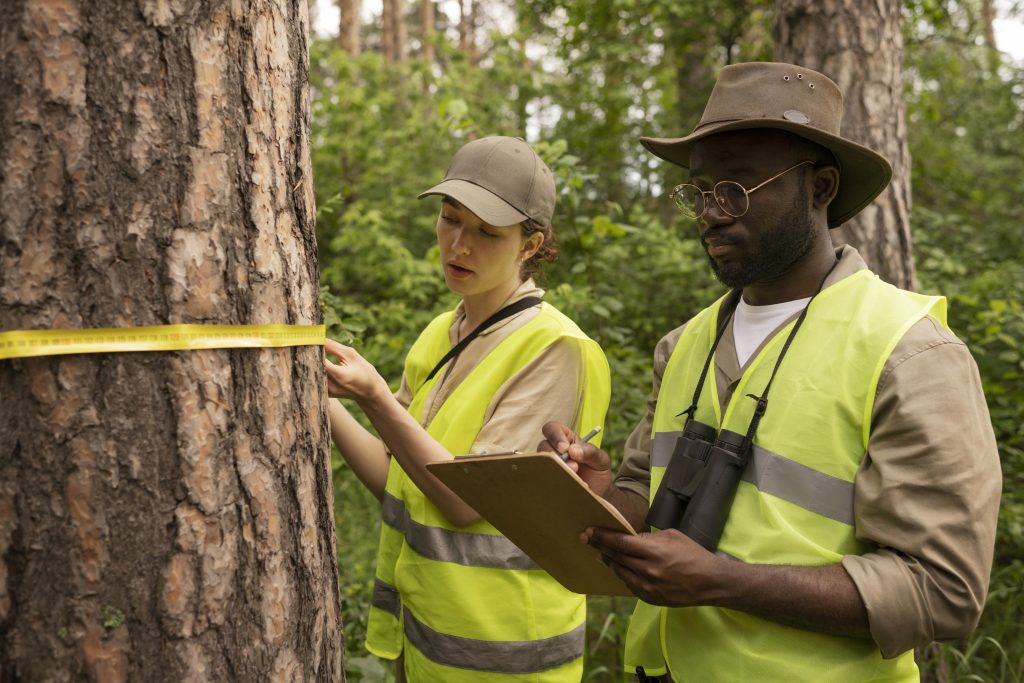Common myths about tree care are misconceptions or incorrect beliefs that can lead to improper practices and potentially harm trees. It’s important to debunk these myths to ensure that trees are properly cared for, maintaining their health and contributing positively to the environment.

Here are explanations of some common myths about tree care:
• Explanation: Regular pruning is essential for tree health. Proper pruning removes dead or diseased branches, improves tree structure, and enhances air circulation. Neglecting pruning can lead to safety hazards and hinder healthy growth.
• Explanation: Young trees need careful attention to establish strong root systems and healthy growth. Proper watering, mulching, and protection from pests and diseases are crucial during their formative years.
• Explanation: Topping, or severe pruning, is harmful to trees. It removes a large portion of foliage, reducing the tree’s ability to produce energy through photosynthesis. Topped trees are more vulnerable to diseases and stress.
• Explanation: While staking can provide temporary support for newly planted trees, it’s not always necessary. Improper staking can restrict natural movement, leading to weak root development and girdling.
• Explanation: Mulching provides insulation, moisture retention, and weed suppression. However, improper mulching (such as piling mulch against the trunk) can cause moisture-related diseases and damage to tree bark.
• Explanation: Trees compartmentalize wounds rather than healing them as animals do. Proper pruning cuts and care can facilitate the tree’s natural compartmentalization process, aiding in wound closure.
• Explanation: Fertilization should be based on soil tests and specific tree needs. While it can address nutrient deficiencies, other factors like soil compaction and drainage issues must be considered for holistic care.
• Explanation: Wound paints or sealants are unnecessary and can sometimes trap moisture and promote decay. Trees naturally compartmentalize wounds, and proper pruning is more effective for wound management.
• Explanation: Tree roots grow both deep and wide, with a significant portion located in the top 12-18 inches of soil. Proper care of surface roots is crucial to tree health.
• Explanation: Mature trees can benefit from care and interventions. Pruning, proper watering, and soil management can help extend the life of older trees.
• Explanation: Insects play diverse roles in tree ecosystems. Some insects are beneficial, like pollinators, while others can be pests. Identifying the specific insect and its impact is essential for appropriate action.
• Explanation: Certified arborists have specialized training and expertise, while unqualified individuals may lack proper knowledge. Hiring certified arborists ensures that trees receive professional care.

• Explanation: Human activities impact natural ecosystems. Responsible tree care, even in natural settings, can help mitigate negative effects and promote healthy ecosystems.
By understanding and dispelling these common myths, property owners, managers, and arborists can make informed decisions and practices that promote the well-being of trees and contribute to sustainable tree management. Debunking myths about tree care is crucial to promoting proper tree health and management for several significant reasons:
• Accurate Knowledge: Myths often perpetuate incorrect practices that can harm trees. Debunking myths ensures that accurate and science-based information guides tree care practices, promoting the best possible outcomes.
• Preventive Care: Correcting misconceptions helps prevent potential problems before they arise. By understanding proper tree care, individuals can take preventive measures to maintain tree health and address issues proactively.
• Tree Longevity: Proper care practices, rooted in accurate information, contribute to the longevity of trees. Trees that receive appropriate care are more likely to thrive, resist diseases, and withstand environmental stresses.
• Environmental Impact: Healthy trees provide numerous environmental benefits, such as improving air quality, reducing energy consumption, and supporting wildlife habitats. Proper tree care ensures these benefits are maximized.
• Safety: Debunking myths reduces the risk of unsafe practices. By understanding the right way to care for trees, individuals can prevent safety hazards like falling branches or improperly managed trees.
• Property Value: Well-maintained trees enhance property aesthetics and value. Correcting myths and implementing proper care practices helps preserve property investments.
• Liability Reduction: Misguided practices due to myths can result in accidents or property damage. Debunking myths reduces the likelihood of legal liabilities arising from improper tree care.
• Professional Expertise: Certified arborists and tree care professionals possess specialized knowledge. Debunking myths encourages people to seek expert advice for tree care, benefiting both trees and property owners.
• Educational Opportunities: Correcting myths provides opportunities for learning and raising awareness about proper tree care. This education empowers individuals to make informed decisions and share knowledge with others.
• Sustainable Tree Management: Debunking myths supports sustainable practices that maintain a balance between human needs and environmental health. Sustainable tree management benefits current and future generations.
• Economic Savings: Proper tree care prevents unnecessary expenses. Addressing issues correctly from the start reduces the need for costly corrective measures or emergency interventions.
• Community Impact: Collectively dispelling myths fosters a culture of responsible tree care within communities. This contributes to the overall well-being of neighborhoods, parks, and urban landscapes.
• Holistic Understanding: Debunking myths encourages individuals to understand trees as complex living organisms that require careful consideration. This holistic perspective fosters empathy and a deeper connection to nature.
• Adaptation to Change: As scientific knowledge evolves, practices may change. Debunking myths ensures that care practices align with the latest research and understanding of tree biology and ecology.
In essence, debunking myths empowers individuals to make informed decisions about tree care, whether they are property owners, managers, or arborists. By cultivating a culture of accurate information and responsible practices, we collectively contribute to healthier urban and natural environments, where trees thrive and provide a multitude of benefits.
Exploring misconceptions and myths surrounding tree care is an enlightening way to uncover common misunderstandings that often lead to improper practices. By addressing these myths, we can better understand the complexities of tree health and management.
Here are some prevalent misconceptions and myths related to tree care:
• Myth: Some believe that trees can thrive without pruning.
• Reality: Proper pruning is essential for removing dead, diseased, or hazardous branches, improving tree structure, and promoting healthy growth.
• Myth: Trees can naturally heal wounds, similar to how animals heal.
• Reality: While trees compartmentalize wounds, proper pruning and care aid in the process, preventing decay and promoting wound closure.
• Myth: Topping, or severe pruning, stimulates growth and improves tree health.
• Reality: Topping weakens trees, reduces energy production, and increases susceptibility to diseases and stress.
• Myth: All insects that interact with trees are detrimental.
• Reality: Insects play diverse roles in tree ecosystems; some are beneficial for pollination and natural pest control.
• Myth: Fertilizing trees can fix any issues they face.
• Reality: Fertilization should be based on soil tests and specific tree needs, addressing underlying problems is crucial.
• Myth: All newly planted trees need to be staked for support.
• Reality: Staking should be limited to cases where the tree requires temporary support, and improper staking can be harmful.
• Myth: Mature trees are beyond help and should be removed.
• Reality: Mature trees can benefit from proper care, which can extend their lifespan and contribute to ecosystem health.
• Myth: All types of mulch are equally beneficial for trees.
• Reality: Proper mulching practices, including the right depth and placement, are crucial for tree health.
• Myth: Tree roots only grow deep into the soil.
• Reality: Tree roots grow both deep and wide, with many important roots located in the upper soil layers.
• Myth: Applying wound paint or sealants to tree wounds prevents decay.
• Reality: Wound paints are unnecessary and can sometimes trap moisture, hindering the natural healing process.
• Myth: Anyone with some knowledge of trees can provide professional tree care.
• Reality: Certified arborists possess specialized training and expertise, ensuring proper tree care practices.
• Myth: Trees in natural settings can thrive without human intervention.
• Reality: Human activities impact natural ecosystems, and responsible care can mitigate negative effects.
By exploring and debunking these misconceptions, we enhance our understanding of the complexities of tree care. This knowledge empowers individuals to make informed decisions, practice responsible tree management, and contribute to healthier urban and natural environments.
Murray is a city situated on the Wasatch Front in the core of Salt Lake Valley in the U.S. state of Utah. Named for territorial governor Eli Murray, it is the state's fourteenth largest city. According to the 2020 census, Murray had a population of 50,637. Murray shares borders with Taylorsville, Holladay, South Salt Lake and West Jordan, Utah. Once teeming with heavy industry, Murray's industrial sector now has little trace and has been replaced by major mercantile sectors. Known for its central location in Salt Lake County, Murray has been called the Hub of Salt Lake County. Unlike most of its neighboring communities, Murray operates its own police, fire, power, water, library, and parks and recreation departments and has its own school district. While maintaining many of its own services, Murray has one of the lowest city tax rates in the state.
Murray Oakes, Grant Park, Southwood Park, Murray Park, Murray Park Restrooms, Willow Pond Park, Neighborhood Veterinary Care
We had a great experience with TruCo! They were well priced, responsive and prompt. Michael was a pleasure to work with and gave us advice on which plants to put in where we took out our ugly old shrubs. I would highly recommend this company!!!
TruCo Services gets 5 stars from us for customer service. We experienced a few issues with their services this last year and Rob Eccles in senior management, stepped in and immediately handled our issues. He was very committed to making sure they understood our expectations and would execute to make us happy.
I work for a property management company and have the pleasure of working with Rob at a community in Sandy. He has been incredible to work with and always responds in a timely manner. He knows all the homeowners by name and address and is aware of all the "problem" areas when it comes to sprinklers. I never have to worry about following up with him because he always reaches out to provide me with an update. If you're looking to work with someone who takes pride in their job, is professional, and can solve the worst landscaping problems thrown your way, Rob is your guy. Thank you, Rob for all you do!
We have used Truco at 2 of the complexes we manage, they have been great to work with. Good quality service, outstanding customer service with good communication. That's hard to find these days. I highly recommend them. Travis has been awesome to work with.
We use TruCo for a majority of our properties and our home. While other landscaping companies we use come and go for various reasons like cost, communication issues, work performance, etc., TruCo is always consistent in price and work. Also, Rob is the best.